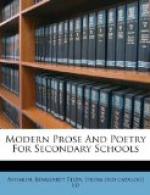Fire attacks the large trees only at the ground, consuming the fallen leaves and humus at their feet, doing them but little harm unless considerable quantities of fallen limbs happen to be piled about them, their thick mail of spongy, unpitchy, almost unburnable bark affording strong protection. Therefore the oldest and most perfect unscarred trees are found on ground that is nearly level, while those growing on hillsides, against which fallen branches roll, are always deeply scarred on the upper side, and as we have seen are sometimes burned down. The saddest thing of all was to see the hopeful seedlings, many of them crinkled and bent with the pressure of winter snow, yet bravely aspiring at the top, helplessly perishing, and young trees, perfect spires of verdure and naturally immortal, suddenly changed to dead masts. Yet the sun looked cheerily down the openings in the forest roof, turning the black smoke to a beautiful brown as if all was for the best.
NOTES
=Kaweah=:—A river in California, which runs through the Sequoia National Park.
=Brownie=:—A small donkey which Mr. Muir had brought along to carry his pack of blankets and provisions. (See pp. 285, 286 of Our National Parks.)
=humus=:—Vegetable mold.
SUGGESTIONS FOR STUDY
In 1875, Mr. Muir spent some weeks in the Sequoia forests, learning what he could of the life and death of the giant trees. This selection is from his account of his experiences. How does the author make you feel the fierceness of the fire? Why does it become calmer when it enters the forest? Would most people care to linger in a burning forest? What is shown by Mr. Muir’s willingness to stay? Note the vividness of the passage beginning “Though the day was best”: How does the author manage to make it so clear? Might this passage be differently punctuated, with advantage? What is the value of the figure “like colossal iron bars”? Note the vivid words in the passage beginning “The thick” and ending with “half a ton.” What do you think of the expressions onlooking trees, and childlike Sequoias? Explain why the burned trees fall up hill. Go through the selection and pick out the words that show action; color; sound. Try to state clearly the reasons why this selection is clear and picturesque.




